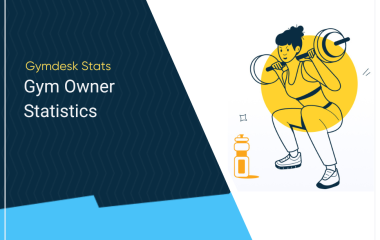Running a fitness business takes more than motivating clients and filling classes. Behind the scenes, one of the biggest hurdles that gym owners grapple with is learning how to run payroll for a gym. Unlike a typical office job, where everyone is expected to work nine to five and receive the same kind of paycheck, a gym has to coordinate trainers, instructors, front desk staff, and managers — all of whom often have different schedules and pay structures.
Get it wrong and you can face frustrated employees, compliance headaches and even fines. Get it right and payroll can quietly drive retention, trust and profit. Indeed, data also indicates that gyms with efficient payroll systems enjoy greater staff loyalty and improved margins than ones constantly plagued by errors.
This article breaks down everything you need to know about gym payroll: from how to obtain tax IDs and classify workers, managing a variety of pay rates, automating time tracking, and choosing a payroll solution that’s right for your operation. Regardless of whether you’re a boutique fitness studio or a multi-location gym, you’ll walk away with a definitive, step-by-step approach to building a payroll system that allows you to save time, keep staff happy, and support long-term growth.
Why Gym Payroll Needs a Specialized Approach
At first glance, payroll might seem universal — calculate hours, subtract taxes, and issue checks. But if you’ve ever tried to manage payroll for a fitness business, you know it’s far from that simple. Some gyms operate with a unique structure, and therefore, their payroll needs are quite different from those of a more traditional office environment.
Multiple Employee Types
Personal trainers, group fitness instructors, front desk staff, sales reps and cleaning crews might be employed at the average gym, as well as supervisors. Both positions have different pay structures, roles and responsibilities. Payroll systems have to be flexible enough to accommodate such diversity without errors.
Varied Compensation Models
Although they may not typically receive a straight salary like employees in other industries, fitness center workers can work within various different compensation models. Trainers usually make a cut of whatever their session will be, and with instructors (in most cases), it is pay per class, normally ending in bonus pay for attendance. Front desk staff are typically paid hourly. This mix of pay points requires an advanced payroll system that can deal with complexity.
Fluctuating Schedules
Instructors may be on a rotation basis, depending on what week or time of year. In the case of trainers, their schedules can ebb and flow with client bookings, while a class instructor might be asked to move in on an extra class for someone who can’t show up at their customary time. This constant state of flexibility doesn’t lend itself to being managed through payroll systems that are built for fixed schedules. To avoid under or overpaying, a gym-specific payroll solution is required.
Compliance Issues
Labor and tax laws add an additional layer of difficulty. Guidelines for overtime, deciding whether someone is an independent contractor or employee and rules that can differ by state all go into the calculus of how gyms should enact their payroll. Not only does not meeting any of these requirements make for an unhappy workforce, but it can also lead to significant fines or investigation.
The Business Case for Accuracy
A 2023 industry survey revealed that gyms with accurate payroll systems experienced 18% higher staff retention and 12% better profit margins compared to those plagued by payroll errors. The upshot is simple: your payroll isn’t just administrative; it’s tactical
Key Steps to Set Up Payroll for a Fitness Business
When you run payroll for a gym, it is more than just writing checks: you must establish process templates that are legal and flexible enough to accommodate the staff structure of your facility. Here are the basic steps in payroll procedure that every fitness business owner should take.
- Register Your Business and Get Tax IDs
You need to obtain authorization before you can legally pay employees, Here’s what you’ll need:
- Employer Identification Number (EIN): Gives your gym a Social Security number. Apply directly on the IRS website. Processing is immediate online.
- State Tax ID: Each state requires that you register your business with its tax authority. The timeframe for processing varies by state, but usually is 1-2 weeks. This number is used simultaneously to remit and collect state income taxes – including local taxes in rural areas.
- Local Business Permits: Depending upon where your gym is located, you might need other permits – not only state ones – to use a payroll service. Better to call the business office in the city or county to see where you stand than deal with laws later on.
Without these boundaries being in place, it is not legal to pay someone his wages or file payroll taxes at all – making this a vital first step in creating a dependable payroll system.
2. Classify Employees and Contractors
Next, you must correctly categorize your staff. Misclassification is one of the most frequent errors in gym payroll and carries heavy fines.
- W-2 Employees: They are paid regular wages, have taxes withheld, and are entitled to mandatory benefits.
- 1099 Contractors: This type of worker gets paid by the job, class, or session. They are responsible for paying their own taxes and do not receive any employee benefits. The company does not withhold payroll taxes for them. These are positions like: freelance personal trainers, substitute instructors.
- Legal Criteria: Guidance given by the Internal Revenue Service will show you how to make a distinction between an employee and a freelancer. A lot of people will be classified as employees if they follow your schedule, use your equipment, and represent the company to customers-even if they are officially listed on contracts as contractors.
- Common mistakes: Many gyms wrongly think that bootcamp and Spinning instructors are independently contracted under IRS law but should in fact treat these stand-alone workers as employees. Failure to do so can cause audits, back taxes as well as penalties.
- Tax Impact: Classification affects payroll taxes, benefits, and legal obligations.
| Classification | Tax Withholding | Benefits Eligible | Payroll Taxes Paid By Gym | Common Roles |
| W-2 Employee | Yes | Yes | Yes | Front desk, managers |
| 1099 Contractor | No | No | No | Freelance trainers |
3. Choose a Payroll Schedule and Frequency
The first decision that needs to be made when setting up payroll for your gym is over how often people get paid. The right schedule balances cash flow, staff expectations, and legal compliance.
Common Payroll Options
- Weekly: Great for employees who need a paycheck every week, like trainers and part-time instructors.
- Bi-weekly (twice a month): The most popular gym option, striking a balance between providing social staff satisfaction, while still allowing a level of cash flow they can manage.
- Semi-monthly (bi-monthly): Works well for salaried employees, but can be frustrating for hourly positions with varying hours.
- Monthly: Easiest to implement for small, stable teams but can be a source of tremendous frustration for staff accustomed to more frequent pay.
Factors to Consider
- Cash Flow Impact: If you’re going to be running more frequent payrolls throughout the month, you need more cash on hand to afford it.
- Staff Desires: Trainers like weekly pay to mesh with their client sessions.Office staff are used to bi-weekly or quasi-bi-monthly paid cycles.
- State Laws: Minimum pay frequency is regulated state by state. Be sure to check local laws before making your final decision.
Decision Framework:
- Small staff or high turnover? → Weekly or biweekly would make sense.
- Stable, salaried staff? → Semi-monthly generally works well.
- State requirements should always be consulted to ensure compliance.
4. Set Pay Rates and Commission Structures
Fair wages and salary is the central feature of payroll issues in a gym. Because the functions of employment in fitness are so varied, a pay structure has to be able to support many models.
Key Approaches:
- Market Research: Review salary surveys from fitness organizations to gauge competitive rates in your area.
- Tiered Commissions: Incentivize trainers with higher percentages as they acquire more clients, certs, or years of service.
- Group Instructor Pay: Pay per class with bonuses possible based on attendance.
- Incentivize: Give for client retention, class attendance, upsell memberships or retail sales.
Example Compensation Structures:
- Personal Trainers: 50-60% commission per session
- Group Fitness Instructors: $25/class + $2 per each participant on top of 10
- Front Desk Staff: $15/hr + monthly performance bonus
Pro Tip: Communicate pay structures to staff so expectations are clear, and disputes diminished.
5. Implement a Reliable Time-Tracking Method
Accurate time tracking is the lifeblood of the payroll. Without it, the most brilliantly engineered comp plan in the world is worthless.
Options for Fitness Businesses:
- Electronic Time Clocks: Automating means less risk of human error and less friction of reconciliation.
- Gym Management Software Integration: Sync staff schedules and class attendance to payroll.
- Mobile Work — Let trainers punch in/out with their phones, ideal for session-based roles, for example.
- Manual Tracking: A few gyms still rely on paper timesheets for their employees, but they are fraught with errors and take a lot of time.
Key Point: A barbell timer not only avoids payroll arguments, but it also ensures your gym stays within the boundaries of labor laws.
6. Calculate Deductions and Withholdings
Once you have determined the gross pay, the next step is to calculate the deductions. This is required for all employees to receive an accurate net paycheck but truly important when it comes to keeping compliance with tax laws.
Required Deductions:
- Federal Income Tax: Withheld on a graduated basis from an employee’s paycheck in accordance with IRS tax tables and the employee’s current W-4 form.
- State and Local Taxes: Vary widely depending on where you operate your business. Some states have no income tax at all, while others require further local withholdings.
- FICA (Social Security and Medicare): Mandatory deductions for all W-2 employees. Currently, 6.2% for social security and 1.45% for Medicare.
- Benefits Deductions:
- If your gym offers benefits, contributions are deducted from payroll:
- Health, dental, or vision insurance premiums
- Retirement plan contributions (e.g., 401(k) or IRA)
- Wellness stipends or other employee perks

Further Withholdings:
Any court-ordered garnishments (for example, child support or wage garnishments) must be subtracted and remitted to the appropriate institution.
Example Calculation:
If a trainer earns $1,000 gross pay in one pay period:
- Federal tax: $100
- State tax: $40
- FICA: $76.50
- Health insurance: $50
- Net pay: $733.50
7. Run Payroll and Maintain Records
After the deductions are calculated, it’s time to process payroll and keep essential documentation.
Payroll Processing Steps:
- Enter hours worked and commissions earned
- Calculate gross pay
- Deduct taxes, benefits and withholdings
- Issue payments (direct deposits, checks or pay cards)
Documentation and Recordkeeping:
- Keep pay stubs, payroll reports, and tax forms on file for at least three years (some states require longer).
- Maintain employee tax documents such as W-2s and I-9s.
Reporting Requirements:
- File quarterly federal payroll tax returns (Form 941)
- File annual reports, such as W-2s and 1099s for contractors
Common Mistakes to Avoid
- Inputting the incorrect hours worked or one’s commission per sale
- Omission of deductions for benefits or garnishments
- Forwarding tax paperwork late or the wrong figures in it
Key Point: Good payroll handling can help you to win your employees’ trust and avoid heavy costs.
How to Manage Taxes and Stay Compliant
Running payroll isn’t over when the checks are cut. Keeping yourself compliant with all the local tax rules is just as important as giving everyone their paychecks on time. Penalties for failing to compute and pay payroll taxes correctly can be stiff, and eventually even call for legal action.
- Quarterly and Annual Filings Form 941 (Quarterly): Reports federal income tax withheld and both employer/employee portions of Social Security and Medicare. Due the last day of the month following each quarter.
- Form W-2 (Annual): Issued to each employee by January 31. Summarizes total wages and taxes withheld. Copies must also be filed with the Social Security Administration.
- Form 1099-NEC (Annual): Required for contractors paid $600 or more in a year.
- Gym-Specific Taxes: In some states, sales tax is levied on memberships, personal training sessions, or specialty courses. This varies greatly from jurisdiction to jurisdiction. Check local and state tax codes to see if you need to tax the services your gym offers.
- Recordkeeping Requirements: All payroll-related paperwork must be maintained for 3–7 years in accordance with federal and state law. This includes:
- Stub checks
- Payroll registers and reports
- Tax filings (941 – 1099s)
- Employee tax and benefit documents
Penalties for Non-Compliance
There are costly consequences if you make payroll tax errors:
- Late filings or payments → fines up to $1,000 per incident
- Failure to deposit payroll taxes → added penalties and interest
- Misclassification of workers → back taxes and benefits owed
Tax Calendar Example for Gyms:
- January 31: W-2s due to employees (and filed with SSA)
- April 15: Annual tax return due (same date as personal income tax)
- Quarterly: Form 941 due the last day of the month after the quarter ends (April 30, July 31, October 31, January 31)
Pro Tip: Use payroll software or outsource tax filings to minimize risk. Automation ensures you never miss a deadline and helps avoid costly penalties.
Choosing the Right Gym Payroll Solution
With so many pieces, such as multiple pay levels, changing schedules and complex tax demands, it’s imperative to possess a gym payroll solution you can count on. The right kind of software can knock hours off your manual workload, liberate you from making errors and give your workers confidence that they will always be paid accurately.
Key Features To Look For:
- Automatic Tax Calculation: Automatically handles federal, state, and local taxes, reducing the chance of mistakes.
- Direct Deposit: Fast, secure and most employees’ preferred choice.
- Support for Multiple Pay Rates: Essential for gym staffers with diverse pay structures including trainers, instructors, and plain workers.
- Gym Management Software Integration: Imports clients, schedules, and session information directly into payroll. This also precludes double entry.
Integration Matters
A payroll system integrated with your fitness studio payroll and gym management tools saves time and effort. For example, trainer sessions as well as class attendance can automatically feed into payroll, eliminating the need for manual entry and lowering error rates.
Cost Considerations
- Monthly Fees: Most providers charge a base fee starting at $30–$60.
- Per-Employee Charges: Expect $4–$6 per employee per month on top of the base fee.
- Setup Costs: Some services charge one-time onboarding fees.
Compare providers not just on price but on the value they deliver in accuracy, compliance, and time saved.
Ease of Use and Support
A platform with an intuitive dashboard makes it easy to add new personnel, update pay rates and process payroll in minutes. Equally important is strong customer support–look for 24/7 access or reps who are familiar with the sports and leisure industry.
Pro Tip: Always demo payroll software before you commit. A quick 15-minute walk-through can tell you whether the interface feels user-friendly and if the provider understands the unique needs of health clubs.
| Payroll Solution | Gym Integration | Multi-Rate Support | Cost/Month | Ease of Use |
| Gusto | Yes | Yes | $40+ | High |
| ADP | Yes | Yes | $60+ | Medium |
| Paychex | Yes | Yes | $59+ | Medium |
| Gymdesk Payroll | Yes | Yes | $30+ | High |
Handling Multiple Pay Rates and Staff Roles
Running gym payroll usually requires the management of multiple pay structures that differ across various jobs. Unlike traditional businesses with mostly salaried or hourly employees, fitness businesses often need to juggle hourly staff, class-based instructors, and commission-driven trainers — sometimes all in the same pay cycle. A strong gym payroll program will be necessary to cope with such complexity.
1. Front Desk and Administrative Staff
These employees generally make up the backbone of daily gym operations.
- Hourly Rates: Typical pay for scheduled shifts.
- Overtime: Federal law (FLSA) dictates time-and-a-half for hours worked beyond 40 in a week.
- Shift Differentials: Offer extra pay for night or weekend coverage.
- Performance Incentives: Augment pay with bonuses for membership sales, upselling services and excellent customer satisfaction.
Example: A front desk associate earns $15/hour, plus $50 if they exceed monthly membership sales targets.
2. Group Fitness Instructors
- Payment Per Class: A flat rate for every class taught.
- Incentive Payments: Extra fees for classes that attract a higher-than-average number of participants.
- Certification Differentials-Advanced or special certification yields higher pay (for example: Yoga therapy, Pilates reformer).
- Substitution Policies: Clear guidelines for how substitutes are paid when they cover classes
Example: An instructor of Hatha Yoga gets $30 per session and $3 per person over fifteen attendees.
3. Personal Trainers and Session-Based Roles
- Trainers typically earn income directly from the sessions or packages they sell.
- Commission Structures: Percentage of the session fee or package price.
- Session Packages: Payments should be tracked as sessions are redeemed, not all at once.
- Retention Bonuses: Reward trainers for keeping clients long-term or upselling package renewals.
- Income Tracking: Gym management software can log sessions, payments, and automatically calculate trainer earnings.
Example: A personal trainer earns 55% of each $60 session ($33/session) and receives a $100 bonus for every 10 client renewals.
Key Takeaway: Every role at your gym has its own unique payroll requirements. Creating adaptability within the payroll system –services and software– guarantees fairness, fairness and high morale among all employees in their respective roles at different levels or types of activity.

Automating Time Tracking to Simplify Pay
Time tracking can make or break payroll accuracy. In gyms, where staff schedules often fluctuate and trainers clock in for client sessions rather than standard shifts, relying on manual systems like paper timesheets is a recipe for errors. Automating time tracking not only simplifies payroll but also reduces disputes, saves administrative time, and keeps your gym compliant with labor laws.
Digital Solutions
Modern gym payroll solutions often feature time clocks or link with mobile apps which are specifically for fitness businesses. Staff can clock in/out on a computer, tablet, or even their own smartphones- making sure that the records are accurate for payroll processing.
Biometric and Mobile Check-In
Biometric systems (like fingerprint or facial recognition) and GPS-enabled mobile apps prevent “buddy punching” — when one employee clocks in for another. They can also decrease human error and deliver a safe, verifiable check on staff attendance
Scheduling Integration
Time-tracking instruments built into gym management software can use course schedules and client bookings for staff hours. This eliminates the need for manual entry and makes sure that trainers and instructors are paid just the number of classes or sessions they actually run.
Reporting Made Easy
Payroll-ready reports can be rendered from automated systems in just minutes. Instead of searching for timesheets, you will have clear, accurate data ready to transfer straight into payroll-saving hours every pay cycle.
Implementation Tips
- Train Staff: Walk employees through how to use the new system to prevent confusion.
- Audit Monthly: Review time records at least once a month to catch discrepancies early.
- Expect ROI: Although digital systems may cost some upfront investment, the payoff comes in fewer payroll errors, less chance of disputes and significant time savings for admin staff.
Key Point: Automated time recording not only gives you time back—it also helps build trust with your team by making sure they are paid fairly and accurately.
In-House vs Outsourced Payroll: Which Is Best
One of the most important decisions gym owners face is whether to manage payroll internally or outsource it to a provider. Both approaches have advantages and trade-offs, and the right choice depends on your business size, budget, and growth plans.
1. Benefits of In-House Payroll
For smaller gyms, or those with relatively stable staff, doing payroll in-house can be more efficient and gives you greater control.
- Control: Quick access to payroll data and the freedom to make last-minute changes.
- Cost Savings: Lower ongoing costs when compared with outsourcing for small gyms.
- Customization: You are able to mold payroll into the direct reflection of particular compensation plans or bonus structures.
Resource Needs for In-House Payroll:
- Payroll software with tax filing and real-time automation features
- Staff time invested in payroll processing, compliance, and other related tasks
2. Advantages of Outsourcing
A well-run payroll service can reduce much of the stress and risk for you, particularly as your gym grows.
- Reduced Risk: Payroll experts take care of employer filings, compliance, meeting tax deadlines etc. So fewer mistakes get made.
- Time Savings: Gym owners and managers are able to concentrate on members, expanding the business.
- Scalability: It’s easy to add more employees, contractors or locations as your business expands.
Typical Costs:
- $50-$200/month, depending on staff size and services
3. Deciding Factors for Your Gym
Choosing between in-house and outsourced payroll comes down to weighing your resources against your long-term goals.
- Business Size: Owners of small gyms with a few employees usually should do their payroll themselves. But larger multi-location establishments generally get more mileage from outsourcing it.
- Budget: Compare the cost of a software subscription with the cost of outsourcing.
- Expertise: If you’re not a payroll or tax whizz, then it makes sense to bypass risk and outsource.
- Growth Plans: As your business expands to new services or locations, outsourcing naturally expands with it.
Self-Assessment Tool
To determine whether in-house payroll is right for your gym or you might be better off outsourcing, answer these questions:
- Do you have the time and knowledge to be certain of getting payroll right?
- Are you stable or rapidly expanding in number of employees?
- Do you require advanced reporting, multi-location support, or software integration?
If your answers were yes to the first two and no to the third, consider in-house payroll. If the third was the choice, outsourcing should work better for an expanding gym.
FAQs About Gym Payroll
How often should I run payroll for my gym staff?
Most gyms run payroll on a bi-weekly basis, which strikes a good balance between employee satisfaction and manageable cash flow. Some trainers prefer weekly pay since their income depends on client sessions, while administrative or salaried staff may be fine with semi-monthly schedules. Always check state laws, as some require minimum pay frequencies. Choosing the right schedule helps keep your team motivated and ensures compliance.
What payroll taxes am I responsible for as a gym owner?
As an employer, you are required to withhold federal, state, and local income taxes from your employee’s paychecks. In addition, you must pay social security and Medicare taxes and offer health insurance benefits for all employees (the law called the federal Insurance Contributions Act).
Gyms may also owe state unemployment insurance premiums and other types of taxes on their workers. Complying with these responsibilities is crucial to avoiding fines and penalties.
Can I pay personal trainers as independent contractors?
You can only treat trainers as independent contractors if they satisfy IRS guidelines on the subject. For instance, the contractor typically sets his own hours of business, uses his own tools and finds customers by being a good tradesman. But if you tell him when to work, provide equipment for whatever tasks are required and oversee a contractor’s performance, the chances are that he is an employee who must be paid accordingly. Misclassifying workers can result in audits, back taxes and penalties.
How do I handle payroll for employees who work in multiple roles?
If an employee holds separate positions within your gym — say, teaching classes and working the front desk — you will need to track each role’s hours of work separately. Each position could have a different pay rate, so it’s important to keep clear records in order to ensure employees are compensated adequately. Once you add these hours and rates up, you add together the totals for each pay period to get the employee’s final paycheck. This method also enables you to remain compliant with labor laws and prevent pay disputes.
What payroll records must I keep for my fitness business?
As a gym owner, you are legally responsible for maintaining exhaustive payroll records of every employee. They include pay stubs or time sheets, W-2 or 1099 forms, tax returns and payroll reports. Records may be retained for at least three years, but certain states can have longer retention requirements. Maintaining clear records keeps you on the safe side during audits and maintains transparency among employees.
How can I reduce payroll processing time for my gym?
If payroll is done manually, it can be time-consuming, but technology is your friend. With payroll software integrated with your gym management system, you can automate your timekeeping, tax computations, and payments. Software that can automatically track time can not only reduce errors, but also reduce administrative lag. Not only will you save time, but this will also allow you to concentrate more on scaling your business.
What are the penalties for payroll tax errors?
Underpaying or failing to pay payroll taxes can have severe consequences. Penalties may range from fines, interest on unpaid taxes, as well as paying back taxes owed to federal or state agencies. Repeated offenses may cause even harsher legal or financial measures to be taken against your business in certain cases. Staying on top of accurate and on time tax filings is crucial to keep these risks at bay.
Should I offer a direct deposit for my gym employees?
Yes, offering direct deposit is highly recommended because it’s convenient for both you and your staff. Employees prefer this option as they receive their money quickly and don’t have to wait for paper checks. It also cuts down on administrative costs, such as printing and mailing checks, saving your business time and money.
How do I classify personal trainers—employees or contractors?
Correct classification is important because how you handle payroll taxes and benefits is affected by it. Personal trainers who establish their own schedule, use their own equipment, and work alone may be considered contractors. But they are employees if they conform to the rules set by your gym, use your facilities and have set hours. Misclassification can lead not only to back taxes but also fines, so either carefully review IRS guidelines or seek advice from a payroll professional.
What should I do if an employee disputes their paycheck?
First, listen to the employee’s concern and review the payroll records for accuracy, including hours worked, pay rates, and deductions. Mistakes can happen, so if an error is found, correct it immediately and issue an updated payment. If the records confirm accuracy, clearly explain the breakdown to the employee to maintain transparency and trust. Having organized records and a clear payroll process in place makes resolving disputes much faster and easier.
Grow With Stress-Free Payroll
Efficient payroll management means much more than ensuring that your staff gets paid on time. It is the backbone of your gym’s financial health, staff contentment, and compliance. When it runs well, your team feels appreciated, errors are kept to a minimum, and your business avoids incurring penalties.
By utilizing capable systems and making routine tasks automatic, you release precious time to concentrate on what should always be at the forefront of your mind: making the membership stronger and giving members the best possible fitness experience.
Gymdesk’s integrated payroll features make staff compensation management straightforward. It’s everything in one place, from payroll taxes and regulatory compliance to payments across multiple roles. This means less time worrying about administration and more time building a stronger, more profitable gym.
Ready to simplify your payroll workload and improve your business’s bottom line?
Book a free Gymdesk demo now and practice stress-free payroll management in your business!
 Gym Owner Statistics: The State of Gyms, Member Trends, and Usage Data
Gym Owner Statistics: The State of Gyms, Member Trends, and Usage Data




 EN (English)
EN (English)
 JA (日本語)
JA (日本語)